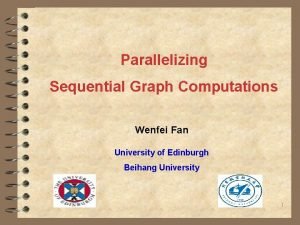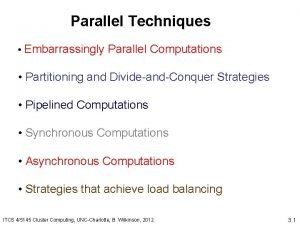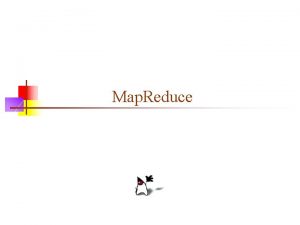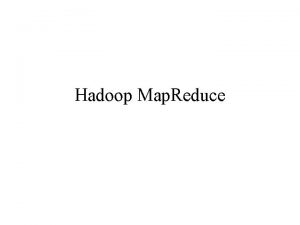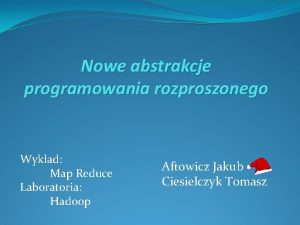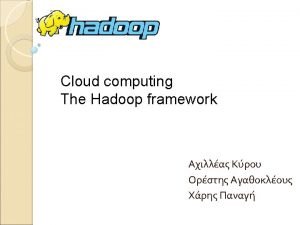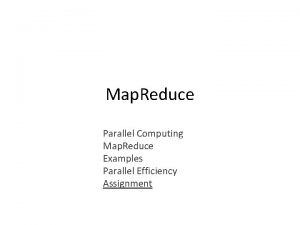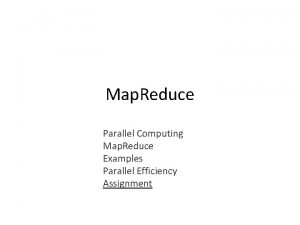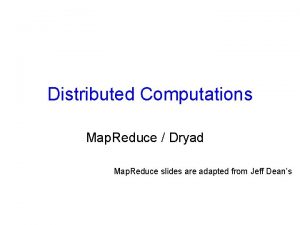Parallelizing Computations Parallel map Map Reduce Idea 1


![Map is an opportunity for parallelizing • map definition map(_, []) -> []; map(F Map is an opportunity for parallelizing • map definition map(_, []) -> []; map(F](https://slidetodoc.com/presentation_image_h/13462d0cb9d53e05582087e3881ecd94/image-3.jpg)






- Slides: 9

Parallelizing Computations • Parallel map • Map. Reduce • Idea 1: take advantage of side-effect-free computation • Idea 2 (again): embody the parallel implementation details in a higher-order function (or module) so the hard stuff is only done once

Map • Recall the common code pattern, for some function f 1, that from one list builds another list consisting of f 1 applied to each of the elements. f([]) -> []; f([H|T) -> [f 1(H) | f(T)]. • We can rewrite this using the higher-order function map f(L) = map(f 1, L).
![Map is an opportunity for parallelizing map definition map mapF Map is an opportunity for parallelizing • map definition map(_, []) -> []; map(F](https://slidetodoc.com/presentation_image_h/13462d0cb9d53e05582087e3881ecd94/image-3.jpg)
Map is an opportunity for parallelizing • map definition map(_, []) -> []; map(F 1, [H|T]) -> [F 1(H)|map(F 1, T)]. • F 1(H) doesn’t depend on other list elements pmap(F, L) -> S = self(), Ref = erlang: make_ref(), Pids = map(fun(I) -> spawn(fun() -> do_f(S, Ref, F, I) end, L), map(fun (Pid) -> receive {Pid, Ref, Ret} -> Ret end, Pids) % what is the type of Pids?

What is the overhead of pmap? • Cost of spawning all the processes • Cost of constructing the Pids list (== cost of constructing the result list) • Cost of sending and receiving each of the Ret values from the spawned processes • Worthwhile: § Enough processors § Enough work in each process

reduce in functional programming • Also known as “fold” it captures the second main recurring pattern in fp count([]) = 0; count([H|T]) = 1 + count(T). • Reduce definition reduce(_, Acc 0, []) = Acc 0; reduce(F, Acc, [H|T]) = reduce(F, F(Acc, H), T). count(L) = reduce(fun(A, H) -> A+1 end, 0, L). sum(L) = reduce(fun(A, H) -> A+I end, 0, L). prod(L) = reduce(fun(A, H) -> A*I end, 1, L).

Map. Reduce • Invented by Jeffrey Dean and Sanjay Ghemawat at Google • Idea: mapreduce(F 1, F 2, L, Acc 0) • § call F 1 on each element of L. F 1 produces as its result a list of pairs [{key, val}] § mapreduce gathers all the vals produced for a given key and § calls F 2(key, [vals], Acc 0) for each key, producing the final result Poor choice of name(? ) § They call F 1 “map” and pass it a pair that they call {key, val}. Using a pair for this argument is not essential § “reduce” is an ok name

What’s cool about Map. Reduce • It encapsulates the pmap idea and the distribution of the spawned processes to different processors • It encapsulates gathering all of the intermediate results with each key into one list (this is tricky to do well on a cluster so doing it once is good) • It encapsulates the distribution of the reduce actions across the cluster • It encapsulates error handling and recovery (processor failures are not rare in large clusters!)

Use of Map. Reduce listwords(Filename) -> % foreach word, w, in the file emit % {w, 1}. reduce. Counts(W, L, _Acc 0) = {w, length(L)}. word. Count(Filenames) -> mapreduce(listwords, reduce. Counts, 0, Filenames). • The Google paper is linked on the website. • Note the use of FP ideas in a system implemented in C++; and note that it is a little clunky around the edges but the key ideas are clear.

Another Use – Word index for set of documents • Want: a list of all the documents that contain each word listwords(Filename) -> % foreach word, W, in the file emit % {W, Filename}. ident(W, L, _Acc 0) -> {W, L}. create. Index(Filenames) -> mapreduce(listwords, ident, 0, Filenames).
